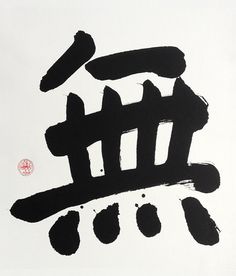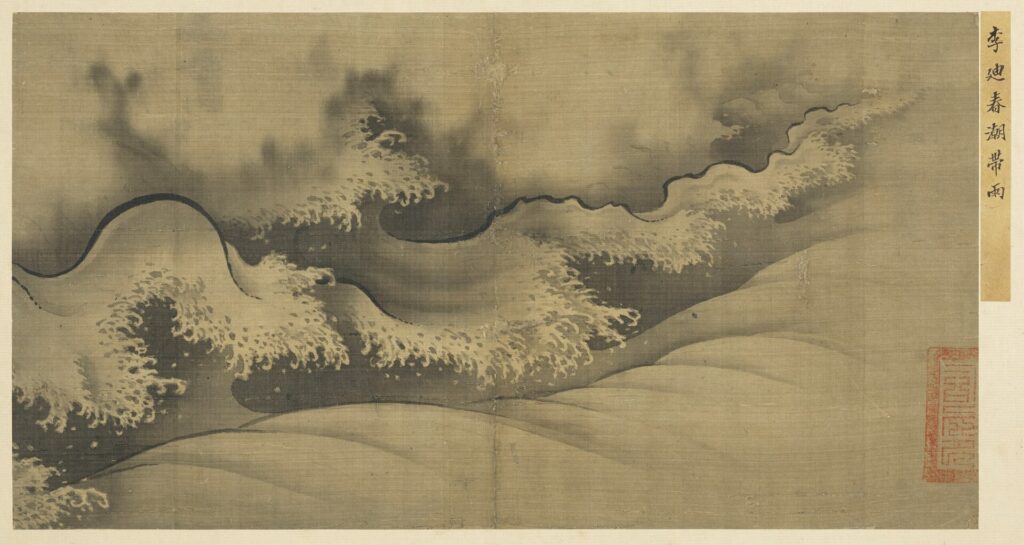“In modern translations of Ch’an texts, “wu” (absence) is never translated in its native Taoist sense. It is often left untranslated … When recognized as a philosophical concept, it is translated with terms like “non-being,” “non-existence,” “void,” all of which introduce a metaphysical realm familiar to Indian Buddhism, but that has nothing to do with Ch’an’s radical empiricism (David Hinton).”
Absence is nearly synonymous with Tao, but emphasizes Tao as the undifferentiated generative source-tissue.

The Chinese ideogram for “wu” (“mu” in Japanese), familiar to Zen meditators practicing koan introspection, is that which David Hinton translates as “Absence.” In his view, “Of Tao’s two elemental principles, Absence and Presence, Absence is the more fundamental. It is nearly synonymous with Tao, but emphasizes Tao as the undifferentiated generative source-tissue.” This emphasis, he says, is “reflected in its etymological origin as the pictograph of a woman dancing, her swirling movements enhanced by fox tails streaming out from her hands.”
Just as meditators in Indian Buddhism were taught to cultivate emptiness by emptying their minds of passing thoughts, in Taoist China, “Cultivation of this Absence as the fundamental nature of consciousness was described as central to Ch’an practice/insight over and over across the tradition.” In Indian Buddhism, however, the goal of the practice was to attain nirvana equated with liberation from suffering. In Chinese Taoism and Ch’an, the goal is to open up to the “undifferentiated generative source-tissue” of the Tao.
In a note, Hinton remarks that “In modern translations of Ch’an texts, “absence” is never translated in that native Taoist sense. It is often left untranslated. Sometimes it is simply left in its Japanese pronunciation mu, which erases the concept entirely (and also represents an act of cultural appropriation, presenting Chinese Ch’an as Japanese). And sometimes it is translated as “no/not.” “No/not” is a common meaning for absence, and so is sometimes correct. But this translation is very often used when the term is clearly meant in its philosophical sense, and when the word is meant to have both meanings simultaneously, which is very often the case in an array of crucial philosophical terms … When recognized as a philosophical concept, it is translated with terms like “non-being,” “non-existence,” “void,” all of which introduce a metaphysical realm familiar to Indian Buddhism, but that has nothing to do with Ch’an’s radical empiricism.”
The Mind Sutra (aka Heart Sutra)
Under the title of Heart Sutra, this is a text which is chanted daily in most Mahayana temples and monasteries. It shares its contents with other Prajnaparamita sutras, but there has been a long controversy about the authorship of its concise version. Precisely as concise, it points to a Chinese origin, only later translated back into Sanskrit, but no consensus has yet been reached among scholars on this issue. With regards to the translation of its title, Hinton explains: “The Chinese title of the Mind Sutra, which is generally mistranslated into English as the Heart Sutra means ‘heart’ and ‘mind’ as a single entity, and ‘heart’ alone has apparently been chosen for emotional appeal. But in Ch’an, the graph should almost always be translated ‘mind’ because the emphasis on consciousness empty of all contents, rather than emotions. And indeed, the Mind Sutra focuses with great concision on Absence/emptiness as the essential nature of mind that must be understood for awakening.”
Hinton adds: “In translations, this emptiness is widely assumed to have the kind of metaphysical implications it would have in Indian Buddhism, suggesting everything is illusory, etc. But in its native Taoist framework, emptiness is synonymous with Absence, which makes the sutra’s proposition quite precise and empirical.” He also notes that the ideogram for “se” repeated throughout the Mind Sutra, is translated as “form,” notably in the formula “form is no other than emptiness, emptiness no other than form; form is exactly emptiness, emptiness exactly form.” “Se” is not a translation of the Sanskrit “rupa.” Hinton says that “‘se’ means ‘color’ or ‘beauty/appearance’, as in a beautiful and even seductive woman. Hence, the sense is very physical and tangible and sensual: ‘this beautiful world of things’, or perhaps ‘the beautiful things of this world’.”
In the Chinese version of the Mind Sutra, Hinton explains, “The emptiness sequence is followed by the even more incantatory sequence, where the graph for wu replaces the graph for ‘emptiness’ as the rhythmic drumbeat. The Chinese ‘wu’ also means ‘no/not’, that simple grammatical function word. As we see again and again, that double meaning is often exploited in philosophical concepts, and here it allows ‘mu’ to be read throughout either in its simple meaning of ‘not’ or in its cosmological/ontological meaning, ‘Absence’. Reading ‘wu’ as ‘not’, the passage reads as a series of negations, which is how translators have always rendered it.”
Hinton proposes the following translation:
“And so, in emptiness this beautiful world of things is Absence,
perceptions Absence, thoughts, actions, distinctions,
Absence eyes and ears, nose and tongue, self and
meaning and ch’i-mind itself,
Absence this beautiful dharma-world,
its color and sound, smell and taste and touch,
Absence the world of sight
and even the world of ch’i-mind, its meanings and distinctions,
Absence Absence-wisdom
and Absence Absence-wisdom extinguished,
Absence old-age unto death extinguished.”
“Absence and Presence are not two separate realms of reality, but are instead a single tissue all origin through and through.”
So, even though there are in the Chinese language two different ideograms for Absence and emptiness, the two are regarded as virtually synonymous, and Hinton sees this as both an issue and an insight. He writes: “It is both confusing and revealing that Absence is virtually synonymous with ‘emptiness’ in Taoist and Ch’an texts. Our language and intellectual assumptions have trained us to interpret such terms as a kind of nonmaterial metaphysical realm in contrast to the material realm of Presence, and ‘emptiness’ generally operates that way in other forms of Buddhism. We interpret Absence and Presence as a dualistic pair, in which Presence is the physical universe and Absence is a kind of metaphysical void from which the ten thousand things of physical reality emerge. But artist-intellectuals in ancient China, whether poets or Ch’an masters, would not have recognized any metaphysical dimensions in this dualism, for they were all thoroughgoing empiricists. And in the empirical reality of the Cosmos, there is no metaphysical womb somewhere, no transcendental pool of pregnant emptiness.”
This means that we will err again if we imagine the “undifferentiated generative source-tissue” as a “transcendental pool of pregnant emptiness,” the way the Tao Te Ching seems to invite us to do when it talks of the “Great Mother who continuously gives birth to all creation.” The metaphysical reflex is so strong in the West that we don’t really understand what it means to stay at the empirical level of the experience! We right away interpret it, turn it into a ‘theory’ in order to ‘universalise’ it. For us, the empirical experience itself has only one purpose: build a theory around it. The end game is not the lived experience, it is ‘knowing’. We have become captive of metaphysics.
Hinton continues: “Absence is emptiness only in the sense that it is empty of particular forms. In normal everyday use, Absence means something like ‘(there is) not’, and Presence means ‘(there) is’. So the concepts of Absence and Presence might almost be translated as ‘form-less’ and ‘form-ful’, for they are just two different ways of seeing the ever-generative tissue of reality. Absence is all existence seen as one undifferentiated tissue (reality, as we have seen prior to our names), while Presence is that same tissue seen in its differentiated forms, the ten thousand things (reality differentiated by our names). And it should also be emphasized that both terms, Absence and Presence, are primarily verbal in Chinese: hence, that tissue of reality is seen as verbal, rather than the static nominal: a tissue that is alive and in motion. Because it is generative by nature, magically generative, the tissue of existence is perennially shaping itself into the individual forms we know – the ten thousand things – and reshaping itself into other forns: the natural process of change, of life and death, transformation and rebirth. From this it follows that Absence and Presence are not two separate realms of reality, but are instead a single tissue all origin through and through.”
The unity of Absence and Presence in the Tao Te Ching
The unity of Absence and Presence, which could be regarded as a strictly empirical formulation of what is translated as the non-duality of duality and non-duality” in what Hinton sees as the metaphysical interpretation of Mahayana Buddhism, was already present in the first chapter of the Tao Te Ching:
“In perennial Absence you see mystery,
and in perennial Presence you see appearance.
Though the two are one and the same,
once they arise, they differ in name.”
Hinton comments: “As is so often the case with Lao Tzu, there is no distinction here between subjective and objective realms. It sounds like he’s talking about objective reality, but it blurs into the realm of consciousness. And of course this is perfectly accurate – for as we’ve seen,it is naming that creates distinctions in the tissue of reality.”
The Unity of Absence and Presence in the Tang and Sung dynasties
Following the publication of the Prajna Absence-Knowing Discourse by Sheng Chao (Sangha-Fundament – 374-414) in which he “interpreted many of the fundamental concepts from [the Indian texts] as Dark-Enigma Learning concepts,” and therefore, “understood Buddhism as a different formulation of Dark-Enigma Learning,” what had been the foundational view of Taoism shaped much of the Chinese culture in the Tang and Sung dynasties, including the Platform Sutra and Ch’an.
In the Platform Sutra, Shen Hui (Spirit-Lightning Gather), said to be Hui Neng (Prajna Able)’s dharma heir, and presenting the teachings of his master, says that, “the essence of awakened prajna-wisdom is simply “seeing Absence”, thereby equating Absence with original-nature in Bodhidharma’s original formulation: ‘seeing original-nature’. Hinton then adds: “And nearing the end of Ch’an’s golden age of development, the Sung Dynasty teacher No-Gate Prajna-Clear (Wu Men) described the ‘gateway to our ancestral patriarchs’ as “the simplest of things, a single word: Absence … No-Gate made Absence the organizing center of his No-Gate Gateway, one of the greatest and most influential works of Ch’an literature.”
Hinton gives two other quotes, that of the Third Patriarch Mirror-Wisdom Sangha Jewel (Seng Ts’an: 529-613) who wrote: “Presence is exactly Absence, and Absence exactly Presence.” and, much later, that of Huang Po (Yellow-Bitterroot Mountain, died in 850): “If you stop seeing in terms of Absence and Presence, you will see dharma itself”
The influence of Ch’an went further than the restricted circles devoted to philosophy and self-cultivation and can be felt throughout Chinese culture in the Tang and Sung dynasties and beyond, as prominent Zen masters in Japan continued to travel to China whenever they could, or seek out Chinese Ch’an masters established on Japanese soil for many centuries. One of its most visible aspects is the Chinese landscape paintings, which also shaped much of Japanese landscape paintings. Here, Tao as a single dynamic and generative existence-tissue “explains why the landscape elements in Chinese paintings also seem infused with Absence, why they are drawn as outlines containing the same pale color that renders emptiness throughout the painting. It’s because the concepts of Absence and Presence are simply an approach to the fundamental nature of things and in the end they are the same: Presence grows out of and returns to Absence and is therefore always a manifestation of it.”
Source:
David Hinton – China Root – Taoism, Ch’an, and Original Zen

